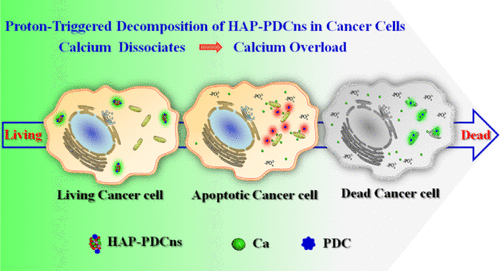当前位置:
X-MOL 学术
›
ACS Appl. Mater. Interfaces
›
论文详情
Our official English website, www.x-mol.net, welcomes your
feedback! (Note: you will need to create a separate account there.)
Activation and Monitoring of mtDNA Damage in Cancer Cells via the “Proton-Triggered” Decomposition of an Ultrathin Nanosheet
ACS Applied Materials & Interfaces ( IF 8.3 ) Pub Date : 2021-01-13 , DOI: 10.1021/acsami.0c20060 Jun W. Liu 1 , Yong G. Yang 1 , Kui Wang 1 , Ge Wang 2 , Cong C. Shen 1 , Yue H. Chen 1 , Yu F. Liu 1 , Tony D. James 3 , Kai Jiang 1 , Hua Zhang 1
ACS Applied Materials & Interfaces ( IF 8.3 ) Pub Date : 2021-01-13 , DOI: 10.1021/acsami.0c20060 Jun W. Liu 1 , Yong G. Yang 1 , Kui Wang 1 , Ge Wang 2 , Cong C. Shen 1 , Yue H. Chen 1 , Yu F. Liu 1 , Tony D. James 3 , Kai Jiang 1 , Hua Zhang 1
Affiliation

|
Mitochondrial DNA (mtDNA) damage is a very important molecular event, which has significant effects on living organisms. Therefore, a particularly important challenge for biomaterials research is to develop functionalized nanoparticles that can activate and monitor mtDNA damage and instigate cancer cell apoptosis, and as such eliminate the negative effects on living organisms. Toward that goal, with this research, we have developed a hydroxyapatite ultrathin nanosheet (HAP-PDCns)—a high Ca2+ content biomaterial. HAP-PDCns undergoes proton-triggered decomposition after entering cancer cells via clathrin-mediated endocytosis, and then, it selectively concentrates in the charged mitochondrial membrane. This kind of proton-triggered decomposition phenomenon facilitates mtDNA damage by causing instantaneous local calcium overload in the mitochondria of cancer cells, and inhibits tumor growth. Importantly, at the same time, a real-time green-red-green fluorescence change occurs that correlates with the degree of mtDNA deterioration because of the changes in the highest occupied molecular orbital–lowest unoccupied molecular orbital energy gaps during this process. Significantly, the decomposition and the fluorescence changes cannot be triggered in normal cells. Thus, HAP-PDCns can selectively induce apoptosis and the death of a cancer cell by facilitating mtDNA damage, but does not affect normal cells. In addition, HAP-PDCns can simultaneously monitor the degree of mtDNA damage. We anticipate that this design strategy can be generalized to develop other functionalized biomaterials that can be used to instigate the positive effects of mtDNA damage on living organisms while eliminating any negative effects.
中文翻译:

通过超薄纳米片的“质子触发”分解激活和监测癌细胞中的mtDNA损伤
线粒体DNA(mtDNA)损伤是一个非常重要的分子事件,对生物体具有重大影响。因此,生物材料研究的一个特别重要的挑战是开发可以激活和监测mtDNA损伤并促进癌细胞凋亡的功能化纳米颗粒,从而消除对活生物体的负面影响。为了达到这个目标,我们通过研究开发了一种羟基磷灰石超薄纳米片(HAP-PDCns)—一种高Ca 2+含量的生物材料。HAP-PDCs通过网格蛋白介导的内吞作用进入癌细胞后,质子触发分解,然后选择性地聚集在带电的线粒体膜中。这种质子触发的分解现象通过在癌细胞的线粒体中引起瞬时的局部钙超载而促进了mtDNA的损伤,并抑制了肿瘤的生长。重要的是,与此同时,由于在此过程中最高占据分子轨道-最低未占据分子轨道能隙的变化,因此发生了实时绿色-红色-绿色荧光变化,与mtDNA降解程度相关。显然,在正常细胞中不能触发分解和荧光变化。因此,HAP-PDCns可以通过促进mtDNA损伤来选择性诱导凋亡和癌细胞死亡,但不影响正常细胞。此外,HAP-PDCns可以同时监测mtDNA损伤的程度。我们预计,该设计策略可以推广用于开发其他功能化的生物材料,这些材料可用于引发mtDNA损伤对活生物体的正面影响,同时消除任何负面影响。
更新日期:2021-01-27
中文翻译:

通过超薄纳米片的“质子触发”分解激活和监测癌细胞中的mtDNA损伤
线粒体DNA(mtDNA)损伤是一个非常重要的分子事件,对生物体具有重大影响。因此,生物材料研究的一个特别重要的挑战是开发可以激活和监测mtDNA损伤并促进癌细胞凋亡的功能化纳米颗粒,从而消除对活生物体的负面影响。为了达到这个目标,我们通过研究开发了一种羟基磷灰石超薄纳米片(HAP-PDCns)—一种高Ca 2+含量的生物材料。HAP-PDCs通过网格蛋白介导的内吞作用进入癌细胞后,质子触发分解,然后选择性地聚集在带电的线粒体膜中。这种质子触发的分解现象通过在癌细胞的线粒体中引起瞬时的局部钙超载而促进了mtDNA的损伤,并抑制了肿瘤的生长。重要的是,与此同时,由于在此过程中最高占据分子轨道-最低未占据分子轨道能隙的变化,因此发生了实时绿色-红色-绿色荧光变化,与mtDNA降解程度相关。显然,在正常细胞中不能触发分解和荧光变化。因此,HAP-PDCns可以通过促进mtDNA损伤来选择性诱导凋亡和癌细胞死亡,但不影响正常细胞。此外,HAP-PDCns可以同时监测mtDNA损伤的程度。我们预计,该设计策略可以推广用于开发其他功能化的生物材料,这些材料可用于引发mtDNA损伤对活生物体的正面影响,同时消除任何负面影响。


















































 京公网安备 11010802027423号
京公网安备 11010802027423号